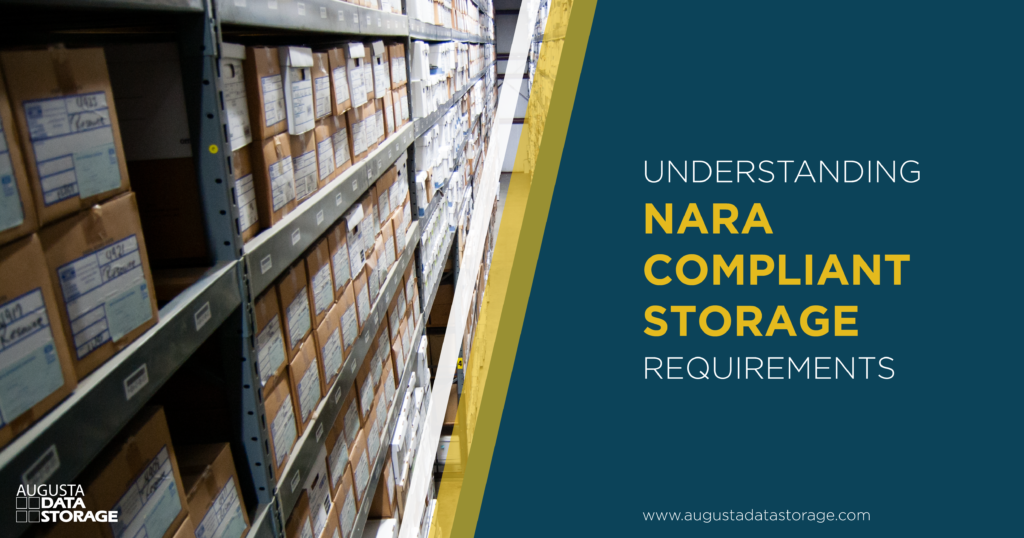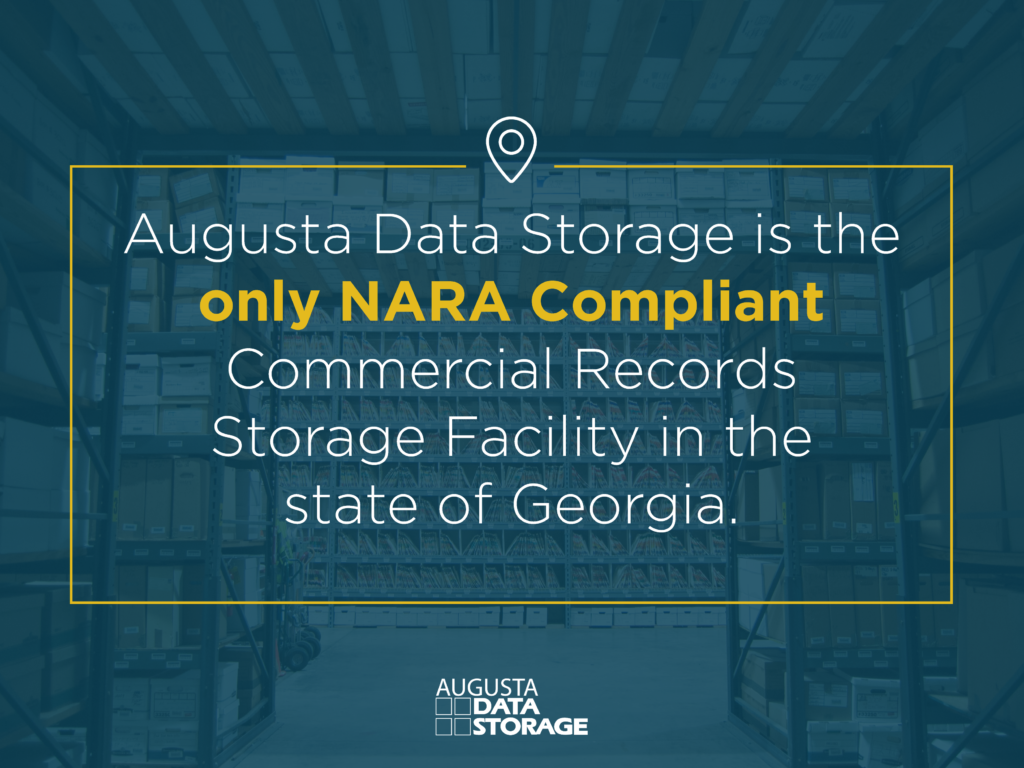Understanding NARA Compliant Records Storage Requirements

Does your organization require NARA Compliant Records Storage? Here’s what you need to know about compliance. Contact Augusta Data Storage to learn more.
What Is NARA?
NARA (National Archives and Records Administration) is an independent agency under the U.S. government that focuses on documenting and preserving historical and government records known as the National Archive. It is also charged with expanding public access to these documents. NARA is responsible for publishing and maintaining the legally authoritative and authentic acts of Congress copies, federal regulations, and presidential directives. And, it examines the Constitutional amendment and Electoral College for an authenticating signature and prima facie legal sufficiency. NARA only works with Federal agencies for storing records and not with commercial storage facility vendors.
NARA storage facilities are also used by:
- The National Archives, Charters of Freedom, is publicly exhibited. It includes the United States original Declaration of Independence, the U.S. Bill of Rights, the U.S. Constitution, and many more historical documents.
- The Federal Register Office publishes the Code of Federal Regulations, the Federal Register, the U.S. Statutes at Large, along with other important documents. Thus, it also manages the Electoral College.
- The “National Historical Publications and Records Commission” (NHPRC) awards funds to local and state governments, colleges and universities, public and private archives, and more nonprofit organizations to publish and preserve historical records.
- The “Office of Government Information Services” (OGIS) enforces the “Freedom of Information Act” (FOIA) for the government and the public.
While NARA manages a network of storage facilities, they also allow for government agencies required to use NARA compliant storage to use approved commercial storage facilities. Augusta Data Storage is the only NARA compliant record storage facility in the state of Georgia.
Federal entities or agencies must secure NARA approval and certify a facility meets 36 CFR 1234 standards before using it to store its records. If a Federal agency placed records in any records storage facility, without securing NARA approval, the entity or agency must commit to the approval process. NARA reviews the certification documentation submitted, and either approves or denies the request. Because stored records are within the custody and legal control of Federal entities or agencies that created them, each entity or agency must submit the proper documentation for NARA approval.

Specs That Have To Be Met for NARA Compliance
NARA sets strict regulations that must be met for agencies to remain NARA compliant. The following are just some of these specs.
- Regional building codes must be followed when designing a facility for protection against building collapse or equipment damage due to tornadoes, earthquake hazards, hurricanes, or other natural disasters.
- Facilities building elements, including walls, floors, and columns, must be built with non-combustible materials. Roof components may be built with combustible materials if they follow local building codes and are protected by a correctly maintained and properly installed automatic wet-pipe sprinkler system, specified in NFPA 13. The facility roof membrane must not allow water to penetrate it.
- A licensed structural engineer must establish floor load limits for the area that records are stored.
- When determining limits, there are a number of factors to consider, such as configuration of space, height and storage equipment or shelving type, the weight of record archives to be stored, the width of aisles, etc.
- The load limit allowed must not be exceeded and must be posted where it is visible for all to see.
- The facilities engineering and architectural design team must work together with a preservation specialist, experienced in developing facilities for archival storage and approved by NARA.
- Each submission stage of the plans must be examined by NWT.
- A facility with multiple stories must be reviewed or designed by a licensed civil/structural engineer and a fire protection engineer to avoid catastrophic structures due to uncontrolled fire on an intermediate floor.
- The document storage area must have an anti-intrusion alarm system, or similar, meeting the UL 1076 requirements, to monitor storage spaces and protect against illegal entry after hours. This alarm system must be continuously monitored in accordance with UL 611.
- Roads, parking areas, and fire lanes must allow unrestricted access to emergency vehicles.

There are also standards that apply to racking and storage shelving systems in a records facility.
- All racking and storage shelving systems must provide seismic bracing meeting the applicable state requirements and regional local building codes.
- Steel shelving, racking systems, or other open shelves must be braced properly to prevent collapsing under a full load.
- Each shelving unit and racking system must be industrial style rated at least 50 lbs. per cubic foot and supported by the shelf.
- If compact mobile shelving systems are used, they must permit fire protection and proper air circulation.
Electronic Records Management
In an effort to provide a standardized, government-wide set of electronic records solutions for federal agencies, core requirements were identified for all businesses to follow. A recent statute was set for all government entities to transfer their electronic records to NARA by December 31, 2022. After that, NARA will not accept paper records.
Electronic records management involves all the information created, indexed, captured, maintained, stored, and received in business transactions. This includes:
- Electronic Documents
- Paper Documents and Files
- Social Media
- Data and Metadata
- Web Content
Electronic records management is basically an integral strategy for businesses to enforce statutory and legal compliance for retention. Transitioning to electronic records management allows for automation, timely destruction, and a decrease in storage costs.
NARA recently released a Digital Preservation Framework that lists 16 electronic record categories along with how they are to be protected by agencies. Each agency must include a records management staff for properly managed records. This staff must ensure systems acquired for mission-related work meet all agency records management requirements by being involved in the agency’s procurement activities. This includes email systems. NARA’s Capstone initiative efforts made significant progress during the past five years.”
Store Your Vital Documents in a NARA Compliant Records Storage Facility
Compliant and secure records management for the Federal Government information and records is the core value of any agency. Protecting and managing these assets is mission-critical. Augusta Data Storage is an electronic records management provider that helps you stay compliant and saves you resources, time, and physical office space. Our federal secure records storage facilities meet the NARA stringent standards and are fully compliant with all codes and regulations. Contact us now to learn more about our NARA-compliant storage facilities.
